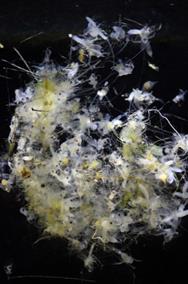Fishhook Waterflea: Lake Champlain’s New Invader
Grand Isle, VT – Researchers confirmed the presence of fishhook waterflea (Cercopagis pengoi) in Lake Champlain, bringing the known number of nonnative and aquatic invasive species in Lake Champlain to 51. The fishhook waterflea is similar to the spiny waterflea, which was confirmed in Lake Champlain in 2014; they are both small crustaceans that are aggressive predators of zooplankton and are known to foul fishing lines. The Finger Lakes and Lake Ontario are the closest lakes known to host fishhook waterflea. The fishhook waterflea likely arrived in Lake Champlain by hitchhiking over land on recreational boats, trailers, or equipment.
The fishhook waterflea specimens were collected just a week ago in the Main Lake segment of Lake Champlain, near Valcour Island and at an established Lake Champlain Long-term Biological Monitoring Program (LTMP) site supported by the Lake Champlain Basin Program. Sample analysis by the Lake Champlain Research Institute (LCRI) at SUNY Plattsburgh confirms high densities with over 100 individuals present in each sample.
Dr. Tim Mihuc and staff at LCRI analyzed Lake Champlain 2018 LTMP samples through June and did not detect fishhook waterflea. This is not a surprise as both species typically appear later in the season. The fishhook and spiny waterflea lay resting eggs that overwinter in the sediment, and once the Lake becomes warm enough they hatch in late July and their densities are highest through early fall. Females also reproduce parthenogenically during the summer season, meaning they grow clones of themselves in a brood sack. Brood sacs were present on the fishhook waterflea that were collected last week. Mihuc states, “This invasion represents a major change in the Lake Champlain food web. Fishhook waterflea is a voracious predator that will eat native plankton species as its main food source.”
LCRI noted that no fishhook waterflea were identified in the 2017 Lake samples from the LTMP, and only a handful of spiny waterflea were detected in 2017. Once all 2018 samples are analyzed, scientists will have a better understanding of how widespread fishhook waterflea is in Lake Champlain. If their distribution pattern follows that of the spiny waterflea infestation the fishhook waterflea will be widespread throughout the Lake by the end of the 2018 season.
The Lake Champlain Basin Aquatic Invasive Species Rapid Response Task Force, which includes representatives from New York State Department of Environmental Conservation, Vermont Agency of Natural Resources, US Fish and Wildlife Service, Adirondack Park Agency, Québec Ministries of Environment and Wildlife, and the Lake Champlain Basin Program, is currently assessing the potential impacts from this detection and evaluating management options. There are no known control technologies to eliminate fishhook waterflea once established in a water body. Efforts will focus on preventing the spread of this species to other bodies of water in the region.
“The detection of fishhook waterflea in Lake Champlain is disappointing and reinforces the need for Lake users to take appropriate spread prevention measures. We have increased our watercraft inspection and decontamination program, in recent years, in partnership with the states, Québec, and the Adirondack Watershed Institute to reduce the risk of all invasive species spread,” said Meg Modley, Lake Champlain Basin Program Aquatic Invasive Species Management Coordinator. Fishhook waterflea and many other aquatic invasive species have life stages that are invisible to the naked eye so it is important to be diligent. Lake users are asked to take spread prevention measures to help prevent the spread of fishhook waterflea to other inland waterbodies.
Native to Eurasia, the fishhook waterflea arrived in the Great Lakes in ballast water in the 1980s, and has since spread to other waterbodies. They feed on tiny crustaceans and other zooplankton that provide food for native species. Fishhook waterflea causes no known risk to human health, though the tail spines of the fishhook waterflea may foul fishing gear. While the impact from this species to the Lake’s food web is unknown, spiny waterflea has altered zooplankton communities in Lake Champlain and other lakes where the species has become established. The eggs are resistant to drying, which has implications for the types of actions that will prevent their spread.
Preventing the spread of fishhook waterflea:
Clean– Inspect and remove plants, animals, and mud from boat, trailer, anchor lines, and angling equipment.
Drain – Drain water from all compartments including the bilge, live wells, bait buckets, storage compartments, etc.
Dry – Allow your boat, trailer, and all equipment including fishing gear, bumpers, ropes, and anchors to completely dry.
Drying times vary based on temperature, humidity, and material. Visit the Aquatic Invasive Species Network for guidance on drying times:
https://www.westernais.org/moving-a-boat
Anglers may have a greater likelihood of seeing fishhook waterflea on their equipment. Some useful tips for anglers include changing fishing line and tackle when moving from one water body to another and carefully inspecting and removing any debris from fishing gear (including rods, spools of fishing line, nets, and downrigger cables). All boaters should focus on draining bilge water and checking anchor lines as they are likely vectors that spread fishhook waterflea. Hot water, high pressure disinfection of boats and equipment that are in contact with water bodies known to contain fishhook waterflea is recommended.
Additional Contacts:
USGS Fishhook Waterflea Fact Sheet: https://nas.er.usgs.gov/queries/factsheet.aspx?SpeciesID=163
-end-
The Lake Champlain Basin Program coordinates and funds efforts that benefit the Lake Champlain Basin’s water quality, fisheries, wetlands, wildlife, recreation, and cultural resources. The program works in partnership with federal agencies, state and provincial agencies from New York, Vermont, and Québec, local communities, businesses, and citizen groups. These partners have led a collaborative, non-partisan effort to address water quality and environmental challenges that cross political boundaries. For further information about the program, contact the Lake Champlain Basin Program, 54 West Shore Road, Grand Isle, VT at (802) 372-3213 / (800) 468-5227 or visitwww.lcbp.org.

